Positive-type photosensitive resin composition and cured film manufactured therefrom
a technology of photosensitive resin and composition, which is applied in the field of positive-type photosensitive resin composition and cured film manufactured therefrom, can solve the problems of uneven film for substrates, lowered residual film rate, and insufficient sensitivity of the above-mentioned conventional photosensitive resin composition containing a naphthoquinone diazide compound, etc., and achieves low film reduction, high transmittance, and high sensitivity.
- Summary
- Abstract
- Description
- Claims
- Application Information
AI Technical Summary
Benefits of technology
Problems solved by technology
Method used
Image
Examples
synthesis example 1
[0169] A solution (concentration of specific copolymer: 27.5 mass %, P1) of component (A) (specific copolymer) having Mn 4,100 and Mw 7,600 was obtained by polymerizing 15.5 g of MAA, 35.3 g of CHMI, 25.5 g of HEMA and 23.7 g of MMA as monomer components constituting a specific copolymer being component (A) with 5 of AIBN as a radical polymerization initiator in 200 g of PGMEA as a solvent at a temperature of 60 to 100° C.
synthesis examples 2-5
[0170] The monomers and solvents indicated in each column of Synthetic Examples 2 to 5 in Table 1 were used instead of the monomer components and solvent used in Synthesis Example 1, and subjected to polymerization according to the procedure and condition similar to those of Synthesis Example 1 to obtain each solution (P2 to P6) of component (A) (specific copolymer). Then, Mn and Mw of the resulting specific copolymers were measured. Each monomer component used in Synthesis Examples 1 to 6 and the measurement results of molecular weight are shown in Table 1.
TABLE 1Synthesis Example No.123456Specific copolymer solutionP1P2P3P4P5P6MonomerMAA (g)15.513.517.515.5CHMI (g)35.311.835.335.7HEMA (g)25.525.526.025.5MMA (g)23.749.221.726.049.2NHPMA (g)41.241.2PEMA (g)32.632.6Solvent*1PGMEA (g)200200200200PGME (g)200200Number average molecular4,1004,2004,8004,2004,8004,200weight (Mn)Weight average molecular7,6007,3009,3007,3008,7007,500weight (Mw)Specific copolymer27.540.523.032.523.028.0conc...
examples 1 to 10
Assessment of Examples 1 to 10 and Comparative Examples 1 to 4
[0191] An anti-reflective coating solution for KrF (DUV-30J (trade name) manufactured by Nissan Chemical Industries, Ltd.) was coated on a silicon wafer with a spin coater, and then baked on a hot plate at a temperature of 205° C. for 60 seconds to form an anti-reflective coating of a film thickness of 140 nm. The positive-type photosensitive resin composition to be assessed was coated on the anti-reflective coating with a spin coater, and then baked on a hot plate at a temperature of 110° C. for 90 seconds to form a coated film of a film thickness of 0.5 μm. The resulting coated film was irradiated with KrF excimer laser reduction projection-type exposure system (NSR-201A manufactured by Nikon Corporation) through a mask of a line and space pattern at 10 mJ / cm2, then subjected to post. exposure bake (PEB) on a hot plate at a temperature of 110° C. for 90 seconds. Thereafter, the coated film was developed by immersing it ...
PUM
| Property | Measurement | Unit |
|---|---|---|
| temperature | aaaaa | aaaaa |
| temperature | aaaaa | aaaaa |
| temperature | aaaaa | aaaaa |
Abstract
Description
Claims
Application Information
 Login to View More
Login to View More - R&D
- Intellectual Property
- Life Sciences
- Materials
- Tech Scout
- Unparalleled Data Quality
- Higher Quality Content
- 60% Fewer Hallucinations
Browse by: Latest US Patents, China's latest patents, Technical Efficacy Thesaurus, Application Domain, Technology Topic, Popular Technical Reports.
© 2025 PatSnap. All rights reserved.Legal|Privacy policy|Modern Slavery Act Transparency Statement|Sitemap|About US| Contact US: help@patsnap.com



